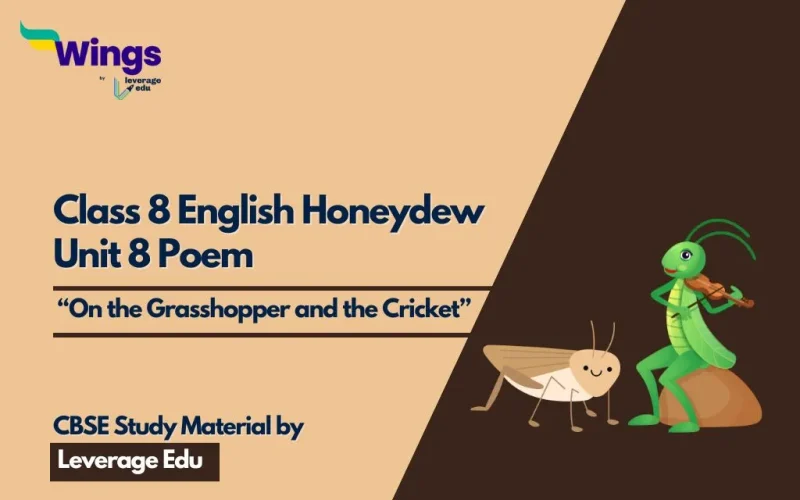NCERT Class 8 Honeydew Unit 8 Poem ‘On the Grasshopper and the Cricket’ is by John Keats. In the poem, the author adores the beauty of the Earth and explains the chemistry of different elements of nature. To help you know about the poem, we have the summary of the poem in the notes. Thereafter, we have NCERT solutions for all the questions under the ‘Working with the Poem’ section in the lesson.
Download NCERT Solutions Class 8 English Honeydew Unit 8 Poem: On the Grasshopper and the Cricket
Contents
You can access the summary of all poems in Honeydew here:
| Unit 1 Poem | Unit 2 Poem | Unit 3 Poem | Unit 4 Poem |
| Unit 5 Poem | Unit 6 Poem | Unit 7 Poem | Unit 8 Poem |
NCERT Class 8 English Honeydew Unit 8 Poem Summary: On the Grasshopper and the Cricket
“On the Grasshopper and Cricket” by John Keats celebrates the everlasting beauty and liveliness of nature throughout the changing seasons. In the summer, the grasshopper chirps happily in the heat, while in winter, the cricket sings in the cold. Even when it seems quiet and still, nature’s music never really stops. Keats shows us that nature’s songs are like poetry that never ends, bringing joy and comfort all year round.
By highlighting different elements of nature, Keats emphasizes the timeless and cyclical nature of the earth’s poetry, which continues to inspire humans regardless of the season.
Important Words and Phrases and Their Meanings
Now, let us look at the important words with meanings essential to understanding the NCERT Class 8 English Honeydew Unit 8 Poem ‘On the Grasshopper and the Cricket.
- Shrills: Loud and high-pitched noise
- Wrought: Brought about
Download NCERT Solutions Class 8 English Honeydew Unit 8 Poem: On the Grasshopper and the Cricket
You can download NCERT Solutions PDF of all poems in Honeydew here:
| Unit 1 Poem | Unit 2 Poem | Unit 3 Poem | Unit 4 Poem |
| Unit 5 Poem | Unit 6 Poem | Unit 7 Poem | Unit 8 Poem |
NCERT Solutions Class 8 English Honeydew Unit 8 Poem: On the Grasshopper and the Cricket
Now, we have important questions and answers from NCERT Class 8 English Honeydew Unit 8 Poem for CBSE students. Let’s proceed!!
Working with the Poem
Ques 1. Discuss with your partner the following definition of a poem.
| A poem is made of words arranged in a beautiful order. These words, when read aloud with feeling, have a music and meaning of their own. |
Ans: A poem is like a beautiful puzzle made of words. These words are put together in a special way to make them sound nice and meaningful. When someone reads a poem out loud and really feels what they are saying, it is like a song. Each word has its tune and feeling. And when you listen, it paints pictures in your mind and makes you feel things too.
Ques 2. ‘The poetry of earth’ is not made of words. What is it made of, as suggested in the poem?
Ans: The beauty of Earth’s poetry is not just found in words but in the rhythmic melodies sung by different creatures of nature. The melodious music of nature constantly changes with the seasons and captivates us. Summer and winter pose challenges for creatures like grasshoppers and crickets, yet also bring them joy and excitement. In summer, grasshoppers happily leap about, resting under foliage when tired. Whereas, in winter’s darkness, crickets fill the nights with their high-pitched songs, a testament to resilience amidst solitude.
Ques 3. Find in the poem lines that match the following.
(i) The grasshopper’s happiness never comes to an end.
(ii) The cricket’s song has a warmth that never decreases.
Ans:
(i) In summer luxury — he has never done with his delights.
(ii) The cricket’s song, in warmth increasing ever.
Ques 4. Which word in stanza 2 is opposite in meaning to ‘the frost’?
Ans: In the second stanza, “grassy” and “frost” are opposites. “Grassy” suggests summer and warm weather, indicating the growth of new life. In contrast, “frost” refers to cold weather, representing the colder months when life struggles to survive.
Ques 5. The poetry of earth continues around the year through a cycle of two seasons. Mention each with its representative voice.
Ans: The beauty of nature’s poetry lasts all year, from summer to winter. In summer, the grasshopper joyfully hops around, representing the earth’s beauty. In winter, the cricket’s song is like a captivating poem of nature. So, the poem cleverly uses these two creatures to show the contrast between the seasons.
Explore NCERT Solutions for all chapters of Honeydew:
| Unit 1 Chapter | Unit 2 Chapter | Unit 3 Chapter | Unit 4 Chapter |
| Unit 5 Chapter | Unit 6 Chapter | Unit 7 Chapter | Unit 8 Chapter |
FAQs
Ans: John Keats is the author of the poem ‘On the Grasshopper and the Cricket’
Ans: In the poem, John Keats talks about the marvellous dynamics of nature, which changes with each season. Also, the poet enlists how different elements of nature change as per the changing seasons.
Ans: The poet talks about birds, grasshoppers, and crickets.
Also, you can access Notes and NCERT Solutions of all chapters in the Class 8 English ‘It So Happened’ textbook
| Chapter 1: How the Camel Got His Hump |
| Chapter 2: Children at Work |
| Chapter 3: The Selfish Giant |
| Chapter 4: The Treasure Within |
| Chapter 5: Princess September |
| Chapter 6: The Fight |
| Chapter 7: Jalebis |
| Chapter 8: Ancient Education System of India |
For NCERT study material, follow CBSE Notes Class 8 English by Leverage Edu now.
 One app for all your study abroad needs
One app for all your study abroad needs














